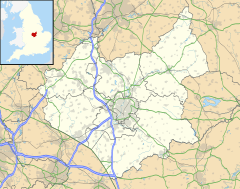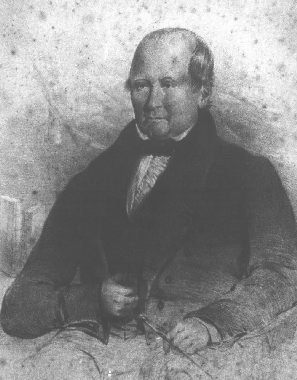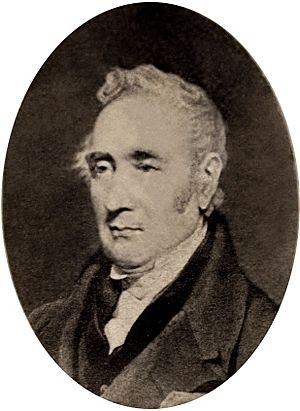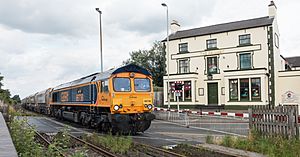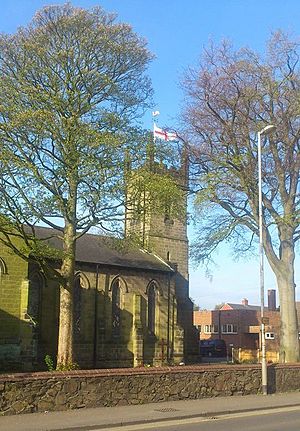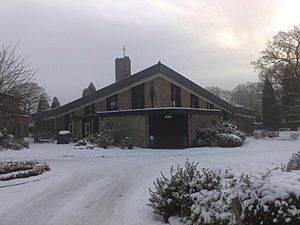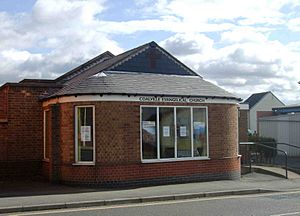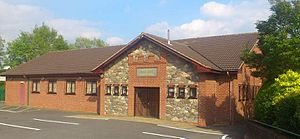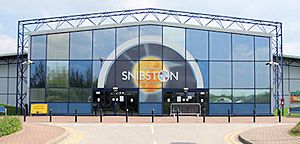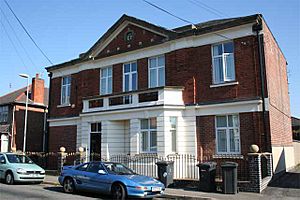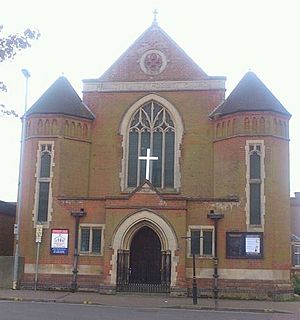Coalville facts for kids
Quick facts for kids Coalville |
|
|---|---|
 Memorial Square and Clock Tower |
|
| Population | 37,661 |
| Demonym | Coalvillian |
| OS grid reference | SK4213 |
| District |
|
| Shire county | |
| Region | |
| Country | England |
| Sovereign state | United Kingdom |
| Post town | Coalville |
| Postcode district | LE67 |
| Dialling code | 01530 |
| Police | Leicestershire |
| Fire | Leicestershire |
| Ambulance | East Midlands |
| EU Parliament | East Midlands |
| UK Parliament |
|
Coalville is a town in Leicestershire, England. It is located in the East Midlands region. In 2011, about 34,575 people lived there. The town is on the A511 road, between Leicester and Burton upon Trent. It is also near the M1 motorway. Coalville is close to the hilly area called Charnwood Forest.
Coalville is connected with Romans-sur-Isère in France. This is called "twinning."
Contents
History of Coalville
Coalville grew during the Industrial Revolution. Its name comes from the coal mining that was very important here. Some people think the name came from "Coalville House," owned by the founder of a local mine. However, a newspaper in 1833 said the new area would be called "COALVILLE" because of the coal traffic.
How Coalville Grew
Before Coalville became a town, it was mostly just a track called Long Lane. This track ran between two toll roads. There were only a few buildings around. One was the Red House, built in the 1700s.
A man named Samuel Fisher described the area in 1832. He said it was mostly wild land with bushes and very few houses. But soon, deep coal mining started. This made Coalville grow very quickly into a modern town.
For a long time, Coalville's history wasn't well known. But in the 1980s, history groups started to record it. Now, the Coalville Heritage Society shares a lot of information about the town's past.
Coal Mining in Coalville
People have mined coal in this area since the Middle Ages. You can still see old mine workings near Swannington. Back then, the coal was close to the surface.
But in Coalville, the coal was much deeper. So, mining here only started when technology improved. The first deep mine was Whitwick in 1824. Then came Snibston in 1831.
A local engineer, William Stenson, was a pioneer in deep mining. He dug through a layer of rock that other miners avoided. This opened up new coalfields. George Stephenson, famous for railways, also started a mine at Snibston. He also created the Leicester and Swannington Railway.
Besides coal, other industries grew in the 1800s. These included quarrying (digging for stone), textiles, and making railway wagons. William Stenson is sometimes called "the Father of Coalville."
Coal mining in Coalville ended in the 1980s. Six mines closed between 1983 and 1991. This meant about 5,000 miners lost their jobs.
The old Snibston mine became Snibston Discovery Park. But it closed in 2015. The land where Whitwick Colliery once stood is now a business park with a supermarket. There's also a small garden to remember 35 men who died in a mine fire in 1898.
The Leicester and Swannington Railway
The Leicester and Swannington Railway was Leicestershire's first railway. It reached Coalville in 1833. There was a small station in Coalville. The railway was later extended to Burton upon Trent in 1845. This made Coalville an important stop for coal transport. More railways were built to connect Coalville to other towns.
Passenger trains stopped running on the Leicester to Burton line in 1964. But the line is still used for goods trains.
There have been talks about bringing passenger trains back to Coalville. But the cost to upgrade the line is very high. So, the plan has not gone ahead.
Important Dates in Coalville's History
- 1824: William Stenson started the Whitwick colliery.
- 1831: George Stephenson started Snibston Colliery.
- 1833: George Stephenson's railway reached Coalville.
- 1836: Coalville's first church opened.
- 1845: The railway connected Burton-on-Trent and Leicester, passing through Coalville.
- 1858: The Bardon Hill quarrying company started.
- 1894: Coalville Urban District Council was formed.
- 1898: The Whitwick Colliery Disaster happened.
- 1925: The Clock Tower (War Memorial) opened.
- 1964: Passenger trains stopped running on the railway.
- 1980s: The coal-mining industry ended.
- 1992: Snibston Discovery Park opened.
- 2015: Snibston Discovery Museum closed.
How Coalville is Governed
Coalville has two main levels of local government. These are the North West Leicestershire District Council and Leicestershire County Council. The district council meets at Stenson House in Coalville.
Changes in Local Government
When Coalville first grew, it was split between four different parishes. In 1894, a larger Coalville district was created. This district became an "urban district." This meant it had its own council.
The urban district council built its own offices in 1934. These offices are now called Stenson House. They are named after William Stenson, who helped found Coalville.
In 1974, the Coalville Urban District was changed. It became part of the new North West Leicestershire district. Stenson House became the main office for this new district council.
Economy of Coalville
After coal mining started, many other businesses came to Coalville. These included flour mills, brick making, and engineering.
During the 1900s, Coalville was home to Palitoy. This company made famous toys like Action Man, Tiny Tears, and Star Wars figures. Palitoy started in 1909 and made its first toy in 1920. The factory closed in 1994.
Aggregate Industries has its main office at Bardon Hill Quarry. It is one of the biggest suppliers of building materials in the UK. The company started in 1858.
TEREX Pegson Limited, based in Coalville, makes mobile crushing machines. These machines are used to break down rocks. The company started in 1830.
Tulip Foods (formerly Belvoir Bacon) was a food factory in Coalville. It started in the 1930s, supplying pork products. The factory closed in 2023.
Many new business parks have opened in Coalville since coal mining ended. Calder Colours, for example, makes art and craft materials. In 2014, they made the red paint for the famous "Blood Swept Lands and Seas of Red" art display at the Tower of London.
In 2016, Amazon opened its largest UK warehouse in Coalville. It is as big as 19 football fields and employs many people.
Transport in Coalville
Buses are the main way to get around Coalville. Arriva Midlands runs buses to Leicester, Loughborough, and Swadlincote. Other companies also run services to places like Hinckley and East Midlands Airport.
The closest train station for passengers is Loughborough. It is about 8 miles (13 km) from Coalville. There have been talks about bringing passenger trains back to Coalville, but it is too expensive right now.
Religion in Coalville
In 2011, most people in Coalville were Christian (60.1%). Many also said they had no religion (32.4%). Coalville has a long history of different Christian churches. Many non-Christian groups have also started in recent years. Different churches in Coalville work together in a group called Coalville Christian Church Unity.
Church of England
Coalville's main church is Christ Church on London Road. It was built between 1836 and 1838. The church has a simple design. It has a tower with four bells. The church also has a plaque to remember the victims of the Whitwick Colliery Disaster of 1898.
The churchyard has the grave of Amos Clarke. He was blind but was the church organist for about 50 years. He was buried as close to the organ as possible, as he wished.
St David's, Broom Leys
St David's is a Church of England church in a northern part of Coalville called Broom Leys. The current building was built in the 1960s.
Baptist Churches
Coalville once had three different Baptist churches. The first permanent church in Coalville was the General Baptist chapel. It opened in 1836. It was on London Road, near where the council offices are today.
Another Baptist church, called "Cave Adullam," was built in 1852. Its name comes from a place in the Bible. This building is now an Indian restaurant.
In 1879, some members left the General Baptist Chapel and formed the Ebeneezer Baptist Church. It was built on Ashby Road in 1881.
Congregationalist (United Reformed Church)
The Bardon Park Chapel, about 3 miles (5 km) from Coalville, is a very old non-conformist church. It was built around 1694. It is now part of the United Reformed Church.
Other Free Churches
- Coalville Evangelical Church is on Belvoir Road.
- Living Rock Church meets at Rothley House.
- New Life Church is on Margaret Street.
- The Full Gospel Mission is a Pentecostal church on James Street.
- The Yesterday, Today and Forever Church is in the old Salvation Army Hall.
Jehovah's Witnesses
Jehovah's Witnesses have a modern building called the 'Kingdom Hall' on Albert Road.
Methodism
Coalville used to have several Methodist churches. They all joined together nationally in 1932. The main Methodist Church in Coalville is now in Marlborough Square.
The old Wesleyan Methodist Chapel on Belvoir Road is now a community center called the Marlene Reid Centre. It is named after Marlene Reid, who helped local voluntary services.
Roman Catholicism
Before 1887, Catholics in Coalville had to travel to Whitwick for Mass. Then, Mass was held in private houses and dance halls. In 1900, a new church was built on Highfields Street. It was called Saint Saviour.
In 1961, the modern Saint Wilfrid of York Catholic Church was built on London Road. It is known for its interesting design. The Cistercian monastery of Mount Saint Bernard Abbey is also close to the town.
Education in Coalville
Coalville has a college called Stephenson Campus. It offers many courses for older students. Stephenson Studio School, for ages 14–18, is also part of the college. However, this school is set to close in 2024 due to low student numbers.
The Castle Rock School and The Newbridge School are for 11–18-year-olds. Newbridge High School was originally the Coalville Grammar School, built in 1909.
The town also has several primary schools, including All Saints, Belvoirdale, Broom Leys, Warren Hills, and St Clare's Catholic Primary School.
Museums in Coalville
Snibston Discovery Museum was built on part of the old Snibston Colliery site. It had interactive exhibits and focused on technology. However, it closed on July 31, 2015, because it was too expensive to run. The main building was torn down in 2016.
Donington le Heath Manor House Museum is a medieval house from around 1280. It was a family home for 700 years. It is now a museum. The house might have once belonged to Sir Everard Digby, who was involved in the Gunpowder Plot of 1605.
Culture in Coalville
Coalville has a rich cultural life.
- The Coalville Male Voice Choir started in 1944.
- The Desford Colliery Band, a brass band, was founded in 1898.
- The Coalville Amateur Operatic Society has been putting on shows since 1919.
- The Coalville Drama Group performs plays and pantomimes at the Old Adult School Hall.
Food in Coalville
The historian William George Hoskins once said that Coalville was known for its "excellent pork pies."
Media in Coalville
The Coalville Times is a weekly newspaper that started in 1893. It covers news for Coalville and the surrounding areas.
Local radio stations include BBC Radio Leicester and Hermitage FM. Hermitage FM is a community radio station that started in 2009.
Sport in Coalville
Coalville Town Football Club, known as 'The Ravens', plays in the Southern League Premier Division Central. They reached the FA Vase final in 2011.
The Coalville Rugby Football Club started in 1902.
The Hermitage Leisure Centre opened in 1981. It had squash courts, a gym, and sports pitches. In 2022, a new, bigger leisure centre called the Whitwick and Coalville Leisure Centre opened. It has a large swimming pool.
The Coalville Greyhound Stadium used to be on Belvoir Road from 1927 to 1990. It was a popular place for dog races.
Leicestershire County Cricket Club has played cricket matches at three different places in Coalville.
Buildings and Landmarks
Coalville has some interesting buildings, even though not many are officially "listed" as historic. The town center has many terraced houses from the late 1800s and early 1900s.
The local council is thinking about making the town center a "conservation area." This would help protect its historic buildings.
A famous landmark in Coalville is the clock tower. It is a war memorial for people from Coalville who died in the two World Wars. The clock tower was built in 1925 and is 68 feet (21 meters) tall. It is a Grade II listed building.
Other important buildings with Grade II listed status include Christ Church, the former Railway Hotel, and the Castle Rock Sixth Form College.
Broom Leys House (now Broom Leys School) is a good example of a wealthy Victorian house. It was built in 1845. During World War I, it was used as a hospital for wounded soldiers. After the war, it became a school.
Coalville Grammar School was built on Forest Road in 1909. It is now Newbridge High School.
The former Belvoir Road Co-operative Store is a large building from 1916. It shows the town's growth between the World Wars.
The former Leicestershire Miners' Association building on Bakewell Street was built in 1926. It was once the headquarters for the miners' union.
The Mantle Lane Signal Box has been watching over the railway bridge for over 100 years. It opened in 1910.
The Market Hall was built in 1975. It houses the town's market. Some people think it would be a good place for a new train station if passenger services return.
The Marlborough Square Methodist Church was built in 1903. It is a good example of local architecture.
The Miners' Memorial Statue is a bronze sculpture. It was put up in 1998 to remember the 1898 Whitwick Colliery Disaster. It honors all miners who died getting coal.
The Mother and Child is a bronze sculpture outside the public library. It was made in 1963. It shows a mother and child, with items in her bag representing Coalville's past industries like mining and toy making.
The Belvoir Centre is a shopping area in the town center. It was built in 1963 and was one of the first modern shopping centers in Leicestershire.
The former Rex Cinema in Marlborough Square has many original art deco features. It opened in 1938.
The former Regal Cinema, also in Marlborough Square, has a unique "faux Egyptian" look. It opened in 1933 and is now a bingo hall.
The old Snibston Mine headstocks are a notable feature to the west of town. They are now a protected historic site.
The Springboard Centre on Mantle Lane is in an old building that was once a wagon works. It now helps small businesses get started.
Stephenson College is a modern building. Its design won an award in 2006.
The Whitwick Business Park is where the Whitwick Colliery used to be. It now has a large Morrisons supermarket and other shops.
Famous People from Coalville
- Hugh Adcock (1903–1975), a former footballer for Leicester City and England.
- Tina Baker (born 1958), a TV presenter.
- William Bees (1871–1938), who received the Victoria Cross for bravery.
- Norman Bird (1920–2005), an actor.
- Tom Hopper (born 1985), an actor.
- Gemma Steel (born 1985), a British long-distance runner.
- William Stenson (1770–1861), a mining engineer and founder of Whitwick Colliery.
- Steve Whitworth (born 1952), a former professional footballer who played for Leicester City and England.
- David Wise (born 1967), a video game music composer.
|
See also
 In Spanish: Coalville para niños
In Spanish: Coalville para niños


